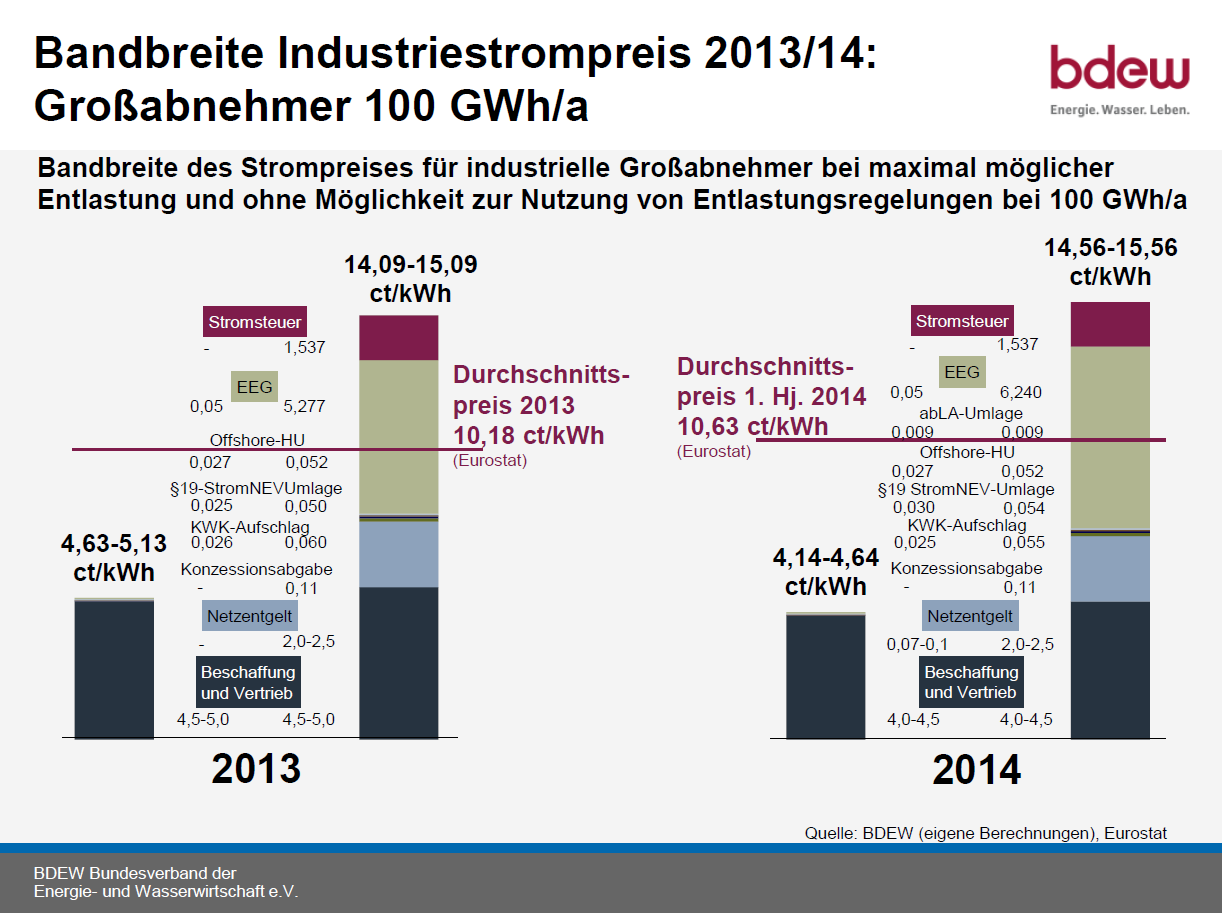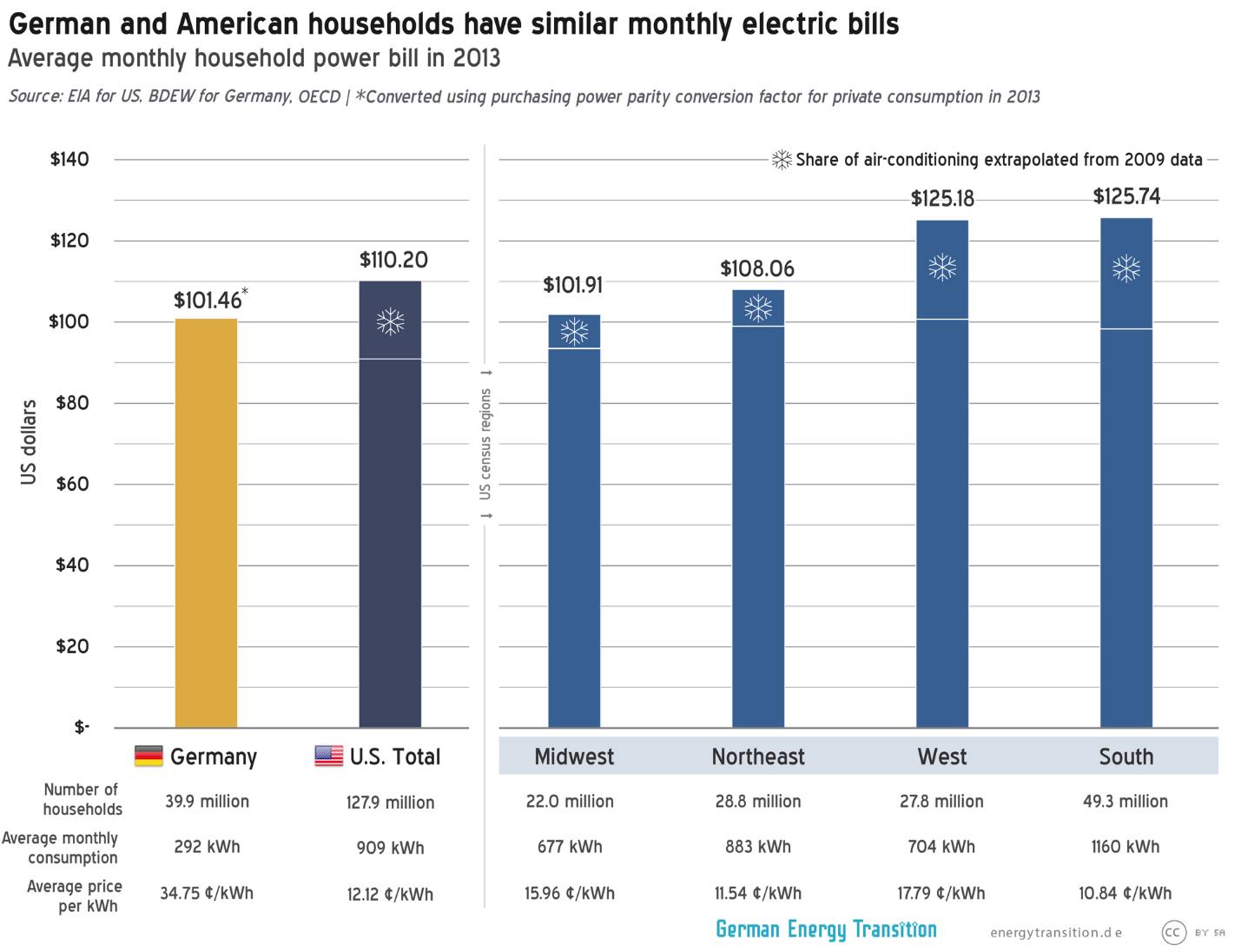In 2015, the average German household power bill fell slightly from 85 euros to 84 euros per month. What’s more, that level is relatively low compared to US averages. But Craig Morris says comparisons are not easy.

A lot of American households have higher electricity bills than their German counterparts. (Photo by alliecat1881, CC BY-NC 2.0)
While Americans pay on average around 12 cents per kilowatt-hour of electricity, Germans easily pay twice as much. Yet, citizens are not demonstrating against the energy transition. On the contrary, when an Energiewende demo takes place, it is always citizens wishing to protect their right to make their own energy.
One reason is that the average power bill is a fairly small part of household budgets. Germans consume only a third as much electricity as Americans do. Their power bills are thus not so large.
But how can we compare these rates? If we do so with the exchange rate, then German power bills currently look very small indeed because the euro has dropped from around 1.30 USD in recent years to around 1.10 USD in the past few months. Convert at that rate, and Germans only pay around 92 dollars a month for electricity – compared to the US average of 110 dollars. But even at the higher exchange rate from 2014, German power bills would still only come in right at around 110 dollars.
Another question is whether Americans simply have more appliances at home. Aside from air-conditioning, which is practically unknown in Germany, Americans and Germans have quite similar creature comforts at home. Granted, homes are larger in the US at around 2,400 square feet, whereas the average German home comes in closer to 1,000 square feet. Likewise, refrigerators and some other appliances are generally bigger in the US. Otherwise, the differences are not that great:
Clearly, Germans are not doing without appliances for a lack of money. So in the chart below, we separate out air-conditioning to isolate the biggest difference between the two countries.
Because the exchange rate has fluctuated so greatly, we opted for a different conversion metric: purchasing power parity. The average German power bill squeaks in at the lowest level of any US census region. However, if the impact of air-conditioning is removed, German power bills would be among the highest. Furthermore, in a state-by-state comparison (here is a PDF listing average power bills by US state) Germany would come in with the 21st lowest monthly power bills, quite close to the middle.
Clearly, the message in this comparison largely depends upon assumptions and the means of conversion. Our chart is therefore not the final word, but we hope it will improve the discussion outside Germany. For instance, the National Review published an article this month claiming that German energy policy is crushing the poor. But their calculations are hard to follow. The author finds that the yearly power bill in Germany is 1,700 USD per person (sic); in the chart above, we see that the annual bill per household (here, assumed to consist of three people) would be around 1,200 USD.
To reach this calculation, the author combines industrial (assumed to be 16 cents) and retail power rates (30 cents) to come up with a composite. But that industry price is extremely high. Roughly 25 percent of German power consumption is largely exempt from the renewable energy surcharge and other levies (such as the grid fee and other taxes), and such energy-intensive firms actually pay closer to four cents.

A chart from German utility lobby group BDEW showing the range of industry power prices and their components: For the purpose of this article, we mainly need to understand that the two bars for 2013 and 2014 show a range of prices that different firms pay depending on what levies are added on to their power price. In 2014, the lowest industry power price was 4.14 cents, whereas the highest was 15.56 cents. Note that the weighted average (red line in the middle) was 10.63 cents, far below the 16 cents estimated by the National Review. Source: Energie-Info of 11 May 2015 (PDF).
By including industrial power rates as a part of per-capita power expenses, the National Review’s estimate includes power costs that go into products and services but are not paid for in household bills. This comparison could be interesting, but the article provides no such figure for the United States. It is therefore unfortunate that the article concludes that “the electricity cost would amount to more than 10 percent of available income. And that is for the median-income household… For the rich, $1,700 per year in electric bills might be a pittance, or at most a nuisance. But for the poor who are just scraping by, such a burden is simply brutal.”
As in other countries, the poor in Germany may very well consume fewer products and services than the rich, so their burden would also be lower. Overall, the Germans spend only a small part of their household budgets on electricity. And as in other countries, the poor spend a larger share of their income on necessities – not just electricity, but heating oil and gasoline as well.

Craig Morris (@PPchef) is the lead author of German Energy Transition. He directs Petite Planète and writes every workday for Renewables International. Thomas Gerke (@Zoido4Design) made the chart comparing US and German power bills.


What is your rate? Just used check24 for a zip code in Hamburg and got 21€ct/kWh even less for Berlin.
Leute- Stomabieter wechseln!!!
An additional effect is that because of the high export intensity of the German economy (and despite the various exemptions of German export industries), some significant fraction of the total electricity costs is recovered from foreign purchases of German goods. This should be subtracted from the $1700. It would nonetheless be interesting to see how the remainder is passed through to the consumer.
Platts:
Power exchange records lowest price for German futures:
http://www.platts.com/latest-news/electric-power/london/german-power-drop-in-wind-lifts-may-29-monthly-26104180
This helps me deal with a common line of attack against an energy transition here in Saskatchewan, Canada. But one question: does that figure of EUR 0.84 include monthly fixed charges, or is it just the cost of the fuel itself?
It would also be worth considering the household income of the bottom 10 and 25% of households in each nation. In the US case and in the UK, that would demonstrate the difference the gini coefficient makes to the acceptability of energy transitions to the fuel poor.
First free electric power delivered:
In Germany the installation of so called “swarm energy” is taking a foothold.
Battery owners unite in a swarm and offer to the grid authority their power, earning money or free electric power.
The company Lichtblick (see search engine) is going big now with Tesla’s powerwall as we’ve read in the news recently.
But there are others as well, Econamicgrid just announced a first free charge for their costumers:
http://www.photovoltaik.eu/Kostenloser-Strom-fuer-Verbraucher,QUlEPTY1NDQ2NSZNSUQ9MzAwMjE.html?UID=601168BBCEA1B7372DFD0AD28283D3EEDEDD36FAD250
Research recently revealed that small PV-power storage systems can beat large pumped hydro storage systems in capacity and flexibility soon:
http://www.pv-magazine.de/nachrichten/details/beitrag/htw-studie–potenzial-von-photovoltaik-speichern-wird-erheblich-unterschtzt_100019346/
PV-clients/power producers not only can store their home-made power with these swarm batteries (this stored power then being cheaper than grid power) but will actually earn money or free power for providing services to the grid authorities.
More and more of these swarm battery organisations are popping-up:
http://www.sonnewindwaerme.de/photovoltaik/schwarm-speichern-franken
The first ones (again: Lichtblick) used gas powered motors from Volkswagen to create a CHP service to their owners. And offering grid stabilization to the authorities.
This model never really became big, the costs being too high and the technical installation too complex.
With the cheap PV and batteries nowadays swarm energy seems to get a foothold in the power distribution system.
(all links are in German language, so use the translation engine)
Are there similar models in the USA where a multitude of small generators/battery owners act as a cooperative selling and taking power from the grid?
German power exchange prices lowest in Europe:
http://www.tennet.eu/de/fileadmin/downloads/news/Hoerchens/TenneT_Market_Review_2014.pdf
A short press launch of the study (in German):
http://www.tennet.eu/de/news-presse/article/tennet-studie-strompreise-in-deutschland-2014-um-12-prozent-gesunken.html
Not only Germany but all neighbors are faced with record low power prices:
http://www.iwr.de/news.php?id=28917
Sweden’s Vattenfall at a loss, there as well record low power prices are recorded:
http://www.mynewsdesk.com/se/elskling/pressreleases/elpriset-ner-34-procent-1171244
Despite that 7 out of 10 Swedish atomic reactors are out of order….
Well manured biomass knocks-out atomic power in the UK:
http://www.bbc.com/news/uk-scotland-glasgow-west-32970794
Power prices remain low:
http://www.platts.com/latest-news/electric-power/london/uk-prompt-power-prices-drop-on-strong-wind-power-26107199
Chechia try to safe atom power by blocking RE-power from Germany:
http://www.mdr.de/sachsen/strom-tschechien-deutschland100.html
Re-power blowing lids 🙂
http://www.br.de/nachrichten/niederbayern/inhalt/temelin-probleme-reaktordeckel-100.html
You are in error: In America we pay on average – 12 cents per KWH. Germany has the 2nd highest cost in the world, next to Denmark: 35 cents per KWH. The truth is that Wind, Solar, Wave, and the like are enormously more expensive than NG, Oil, Coal, and Nuclear. Often, these prices are artificially lowered by government subsidies, but it invaribly, always, catches up with the poor consumer…
Do so research before writing anymore non-truths:
https://www.ovoenergy.com/guides/energy-guides/average-electricity-prices-kwh.html
Sadly many people confuse price with cost. The cost of German and Danish electricity is very low, the price is high for several reasons. Look then up. In the USA we give massive gov breaks to fossils and nuclear, then claim they have low costs: false. They are able to have low prices (not these days), because of gov breaks. Fossils get 5.3T$ in gov breaks globally according to the IMF. Our DOE, is the old atomic Energy Commission, and still 90% mu clear workers and work. NREL and EIA are under them. Not honest brokers. The IEA was founded for protect oil reserves. not honest brokers.
Given the living space is twice that as a average German (homes are larger in the US at around 2,400 square feet, whereas the average German home comes in closer to 1,000 square feet.) Washington has asked us to set our Thermostats to 72F…does anyone know where the average German sets there Thermostat….If I remember correctly Sweaters worn indoors are very popular…
[…] work – more suitable for a complete study than a blog post – so I merely refer you to our comparison of German and US power bills with data from […]
https://www.google.com/search?q=how+much+electricity+does+average+german+use
7000 KWH.
https://www.google.com/search?q=how+much+electricity+does+average+American+use
in 2014, it was claimed at
12000KWH
https://www.eia.gov/tools/faqs/faq.php?id=97&t=3
yet, in 2016, EIA (who runs REAL numbers)
10,766 kwh.
The difference is nominal.